Backbox Relays
Search Relays
Working in conjunction with the search disk of the Control Unit to provide winner detection are five small relays called search relays.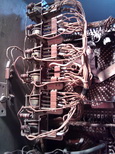
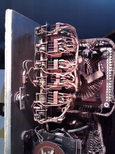
The search disk sequentially scans all possible lines on the backglass bingo card(s). Each time a ball is detected in a hole corresponding to one of the five numbers on the card line being scanned, the search relay corresponding to that number's position in that line is energized. There is one relay for each position in a five number line. Three or more consecutive relays energized at the same time indicates a winning combination.
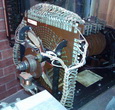



When this occurs circuitry connected with these relays causes the search index coil on the control unit to be energized, thus stopping the search disk wipers on the winner. The corresponding search relays are also held energized and provide information to the payout circuitry as to what type of winner (3-in-line 4-in-line, etc.) has occurred so that the proper payout can be made. Incidently, it is these relays closing and reopening every time a ball is detected during scan that causes that clicking sound characteristic of all bingos.
Trip Bank
Prominently located on the inside of the back door of most bingos is a long bank of relays known as the trip bank.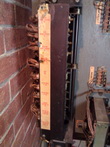
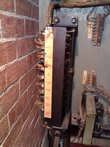
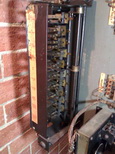
These relays correspond to game features that, once they occur, never happen again until the next game is started. Once one of these relays is tripped it can only be reset by a large solenoid(s), mounted at the end(s) of the bank, which is energized once at the start of each new game.
Game features such as four corners and ballyhole (a feature that when enabled, allows a ball in hole sixteen to do some special function) are controlled by trip bank relays. Another very important relay is called the selector lock. This relay is generally tripped when the fourth ball is shot. In fact, an astute player may hear the click of this relay being tripped as soon as the fourth ball leaves the runway. This relay has two main functions. First, it disables player controlled advantages (turning corners, spot number selection, etc.) that must normally be used before the fourth ball is shot. Secondly, it enables the winner detection and payout circuitry. This is why no bingo ever pays out until after the fourth ball is in play. This relay also enables the yellow button function, so that the player may try for extra balls. Feature hold-over functions, allowing a player to use some advantages after the fourth ball, can delay the functions of the selector lock until either after the fifth or sixth ball is shot. These features also have corresponding relays in the trip bank.
The trip bank also has a relay (most often two relays in tandem) called extra ball. This relay is tripped when the player pushes the yellow button on the front of the cabinet indicating he wishes to play for extra balls. After this relay is tripped any coins or replays played, until the red button is subsequently pushed, set into operation the circuitry that implements the extra ball function, either giving the player an extra ball to play or teasing him into playing more coins or replays in hopes of getting one the next time.
Other Important Relays
In addition to the trip bank and search relays, there is also a small group of relays in the backbox used to control other game functions.
The Start relay operates any time a coin or replay is played and starts the timer cams on the control unit to initiate the feature selection sequence. Other relays control other game functions, such as the red button relay, which is operated when the player pushes the red button to start a new game after playing for extra balls.
BINGOS - FOR AMUSEMENT ONLY

